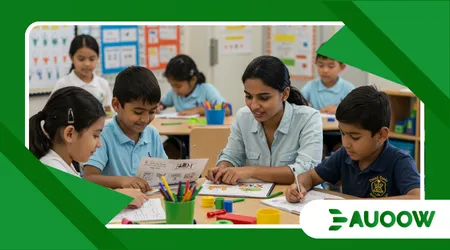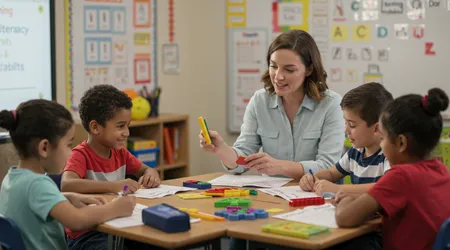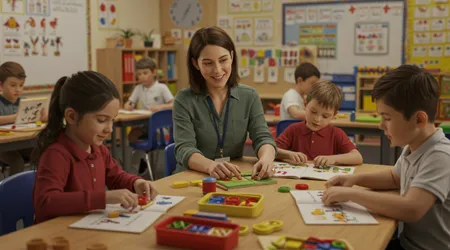Teaching Literacy to Students with Learning Disabilities: Modern Approaches

Teaching literacy to students with learning disabilities is a critical mission in 2025’s inclusive education landscape.
As classrooms grow more diverse, educators face the challenge of addressing varied learning needs while fostering equitable access to literacy.
Students with learning disabilities, such as dyslexia or autism spectrum disorder, often struggle with decoding, comprehension, or fluency.
Yet, modern approaches rooted in evidence-based strategies, technology, and empathy are transforming how we empower these learners.
Why settle for outdated methods when innovative, tailored solutions can unlock a student’s potential? This article explores cutting-edge strategies, offering practical insights for educators and advocates committed to inclusive literacy education.
Literacy is the cornerstone of academic success, yet for students with learning disabilities, traditional methods often fall short.
The National Center for Learning Disabilities (2023) reports that 1 in 5 students in the U.S. has a learning disability, underscoring the urgency of effective interventions.
Today’s approaches prioritize individualized instruction, multisensory techniques, and technology integration.
By blending creativity with research-backed methods, educators can create literacy-rich environments that inspire confidence and competence.
This piece dives into practical, modern strategies, offering a roadmap for teaching literacy to students with learning disabilities with authenticity and impact.
Multisensory Instruction: Engaging All Senses
Multisensory instruction engages visual, auditory, and kinesthetic pathways to enhance literacy learning. For students with dyslexia, combining letter tracing with sound repetition strengthens neural connections.
For instance, a teacher might use sand trays for tactile letter formation while students vocalize sounds. This approach, rooted in Orton-Gillingham methodology, boosts retention and engagement.
Technology amplifies multisensory learning. Apps like Lexia Core5 provide interactive phonics exercises tailored to individual needs.
++ The Best Classroom Layouts for Inclusive Learning
Students with learning disabilities benefit from repeated exposure in varied formats, reducing frustration. Teachers can integrate audio books with visual prompts to reinforce comprehension.
Real-world example: Ms. Carter, a 3rd-grade teacher, uses colored blocks to teach syllable segmentation. Her student, Liam, with dyslexia, thrives by physically manipulating blocks while sounding out words.
Such hands-on methods make abstract concepts concrete, fostering independence in teaching literacy to students with learning disabilities.

Structured Literacy: A Systematic Approach
Structured literacy delivers explicit, sequential instruction in phonics, vocabulary, and comprehension. Unlike whole-language approaches, it emphasizes decoding skills critical for students with learning disabilities.
The International Dyslexia Association (2025) endorses this method for its evidence-based success. Teachers break down reading into manageable components, ensuring mastery before advancing.
Classroom implementation involves clear modeling and guided practice. For example, a teacher might demonstrate blending sounds before students try independently.
This scaffolding builds confidence and reduces cognitive overload. Structured literacy also integrates writing to reinforce reading skills.
Also read: Why Intersectionality Matters in Inclusive Education Policies
Consider Sarah, a 5th-grader with dysgraphia. Her teacher uses graphic organizers to map story elements, helping her structure narratives.
By combining explicit instruction with visual aids, teaching literacy to students with learning disabilities becomes systematic yet flexible, catering to diverse needs.
Assistive Technology: Bridging Gaps
Assistive technology revolutionizes teaching literacy to students with learning disabilities. Tools like text-to-speech software, such as Kurzweil 3000, help students access texts independently.
Speech recognition apps enable those with writing challenges to express ideas verbally. These tools empower students, fostering autonomy and engagement.
Digital platforms offer personalized learning paths. For instance, Bookshare provides customizable e-books with adjustable fonts and audio narration.
Such tools level the playing field, ensuring access to grade-level content. Teachers must guide students in using these technologies effectively.
Read more: How to Evaluate Accessibility in Online Learning Courses
Example: Jake, a high schooler with autism, uses a tablet-based reading app with highlighted text synced to audio.
This dual-input method improves his comprehension, demonstrating how technology enhances teaching literacy to students with learning disabilities.
Collaborative Learning: Building Peer Support
Peer collaboration fosters literacy by creating supportive learning communities. Literature circles, where students discuss texts in small groups, encourage active engagement.
Each student takes a role summarizer, questioner, or illustrator promoting accountability. This approach, supported by the Council for Learning Disabilities (2023), builds comprehension and social skills.
Teachers can pair students strategically, ensuring those with learning disabilities contribute meaningfully.
For example, a student with dyslexia might excel as an illustrator, leveraging visual strengths. Group activities reduce isolation and boost motivation.
In a 4th-grade classroom, Maria, who struggles with reading fluency, shines as a discussion leader. Her peers’ encouragement helps her tackle challenging texts.
Collaborative strategies make teaching literacy to students with learning disabilities inclusive and dynamic, fostering a sense of belonging.
Universal Design for Learning: Flexible Frameworks
Universal Design for Learning (UDL) offers flexible frameworks to meet diverse needs. By providing multiple means of engagement, representation, and expression, UDL ensures all students access literacy instruction.
For instance, offering texts in audio, visual, or tactile formats accommodates varied learning styles.
Teachers can use UDL to create choice-based assignments. A student might choose to write, record, or draw a book summary, catering to their strengths.
CAST’s 2025 guidelines emphasize UDL’s role in reducing barriers for students with learning disabilities.
Example: In a 6th-grade class, Tom, with ADHD, records his book report as a podcast. This creative outlet enhances his engagement, proving UDL’s impact on teaching literacy to students with learning disabilities.
Social-Emotional Support: Fostering Confidence
Literacy instruction must address emotional barriers. Students with learning disabilities often face frustration or low self-esteem.
Building a supportive classroom culture is crucial. Teachers can use positive reinforcement to celebrate small victories, boosting confidence.
Restorative practices, like daily check-ins, help students feel valued. For example, a teacher might ask students to share one success from their reading practice. This fosters resilience and motivation, critical for literacy growth.
In a 2nd-grade class, Emma, with a processing disorder, receives praise for decoding a new word.
This encouragement drives her to persist, highlighting the role of emotional support in teaching literacy to students with learning disabilities.
Data-Driven Instruction: Tailoring Interventions

Data-driven instruction ensures targeted literacy support. Regular assessments, like DIBELS, identify specific skill gaps in phonemic awareness or fluency. Teachers use this data to tailor interventions, adjusting pace and focus for each student.
Progress monitoring keeps instruction dynamic. For instance, if a student struggles with vowel teams, teachers can provide targeted practice.
The National Reading Panel (2020) found that data-driven interventions improve outcomes by 0.45 effect size.
A 7th-grade teacher, Ms. Lopez, uses weekly quizzes to track Ana’s decoding progress. Adjusting lessons based on results accelerates Ana’s growth, showcasing data’s role in teaching literacy to students with learning disabilities.
Family and Community Engagement: A Holistic Approach
Engaging families amplifies literacy success. Parents can reinforce skills at home using teacher-provided resources, like reading apps or phonics games. Workshops empower families to support literacy development effectively.
Community partnerships, such as library reading programs, provide additional resources.
For example, a local library might offer tactile books for students with visual impairments. These connections extend learning beyond the classroom.
A parent, Mr. Chen, reads nightly with his son, Kai, using a recommended app.
This collaboration strengthens Kai’s fluency, proving family involvement’s impact on teaching literacy to students with learning disabilities.
Table: Key Strategies for Teaching Literacy to Students with Learning Disabilities
| Strategy | Description | Example Tool/Activity | Benefit |
|---|---|---|---|
| Multisensory Instruction | Engages multiple senses for learning | Sand trays, Lexia Core5 | Enhances retention, reduces frustration |
| Structured Literacy | Explicit, sequential phonics instruction | Graphic organizers, sound blending | Builds foundational skills |
| Assistive Technology | Tools for access and independence | Text-to-speech, Bookshare | Promotes autonomy, accessibility |
| Collaborative Learning | Peer-based discussion and role assignment | Literature circles | Fosters engagement, social skills |
| Universal Design for Learning | Flexible formats and choices | Audio texts, podcast reports | Accommodates diverse needs |
| Social-Emotional Support | Builds confidence through reinforcement | Daily check-ins, praise | Boosts motivation, resilience |
| Data-Driven Instruction | Uses assessments to tailor interventions | DIBELS, progress monitoring | Targets specific skill gaps |
| Family Engagement | Involves parents in literacy activities | Reading apps, workshops | Reinforces skills at home |
Analogy: Literacy as a Garden
Teaching literacy to students with learning disabilities is like tending a diverse garden. Each plant (student) requires unique care some need more water (support), others thrive in shade (alternative formats).
With the right tools and attention, every plant blooms, just as every student can master literacy with tailored strategies.
Conclusion: A Path to Empowerment
In 2025, teaching literacy to students with learning disabilities demands creativity, empathy, and innovation.
By blending multisensory techniques, structured literacy, assistive technology, and collaborative methods, educators can unlock every student’s potential.
UDL and social-emotional support ensure inclusivity, while data-driven instruction and family engagement create a holistic approach.
These strategies aren’t just tools they’re bridges to confidence, independence, and lifelong learning.
Educators, equipped with these modern approaches, can transform challenges into opportunities, ensuring no student is left behind in the journey to literacy.
The path isn’t easy, but the rewards are profound. When students with learning disabilities read fluently or write confidently, they gain more than skills they gain agency.
As educators, parents, and communities unite, we build a future where literacy is accessible to all. Let’s commit to these innovative strategies and watch every learner thrive.
Frequently Asked Questions (FAQs)
1. What is the most effective strategy for teaching literacy to students with learning disabilities?
Structured literacy, combined with multisensory techniques, is highly effective, as it provides explicit, systematic instruction tailored to individual needs.
2. How can technology help students with learning disabilities?
Assistive tools like text-to-speech and customizable e-books enhance access, promote independence, and support comprehension and expression.
3. How can parents support literacy at home?
Parents can use reading apps, engage in nightly reading, and attend workshops to reinforce classroom strategies effectively.
4. Why is emotional support important in literacy instruction?
Emotional support builds confidence and resilience, reducing frustration and motivating students to persist in their literacy journey.
5. How does UDL benefit students with learning disabilities?
UDL offers flexible learning options, like audio texts or choice-based assignments, ensuring accessibility for diverse learners.
